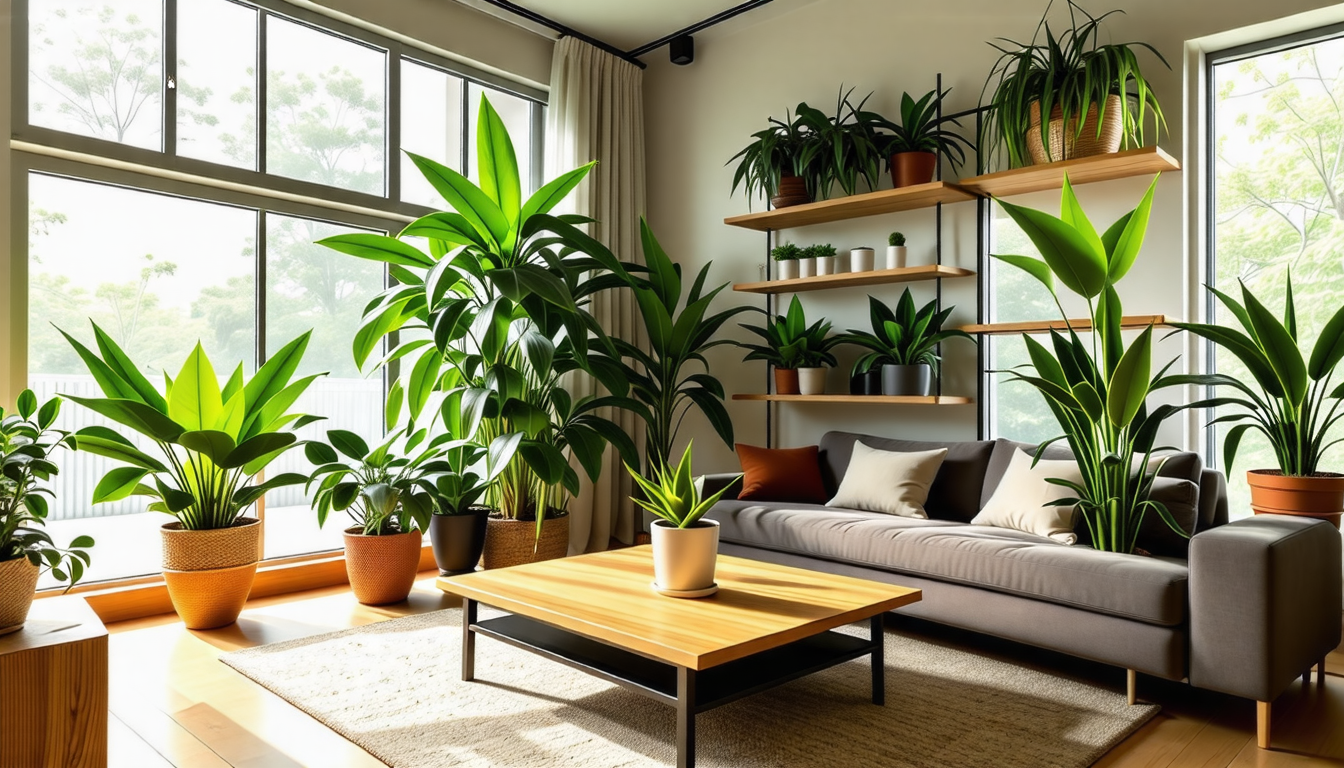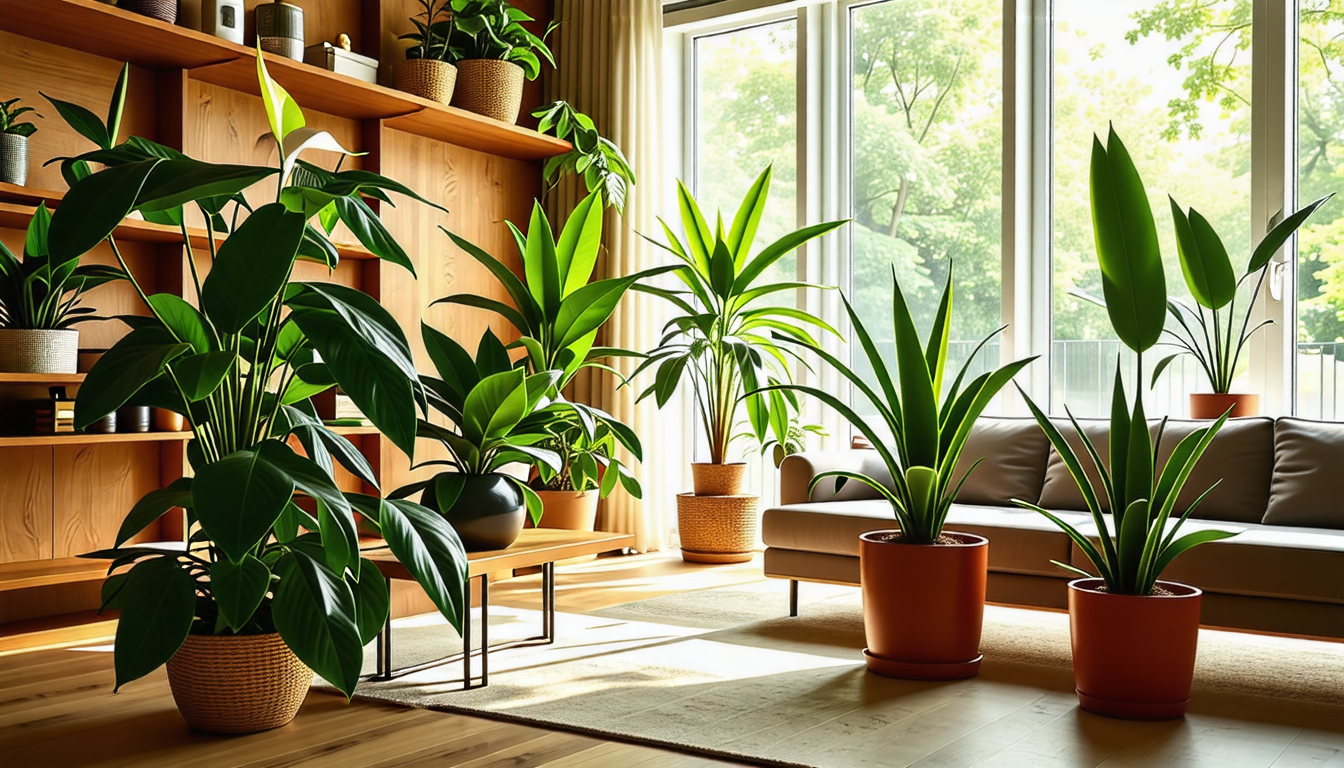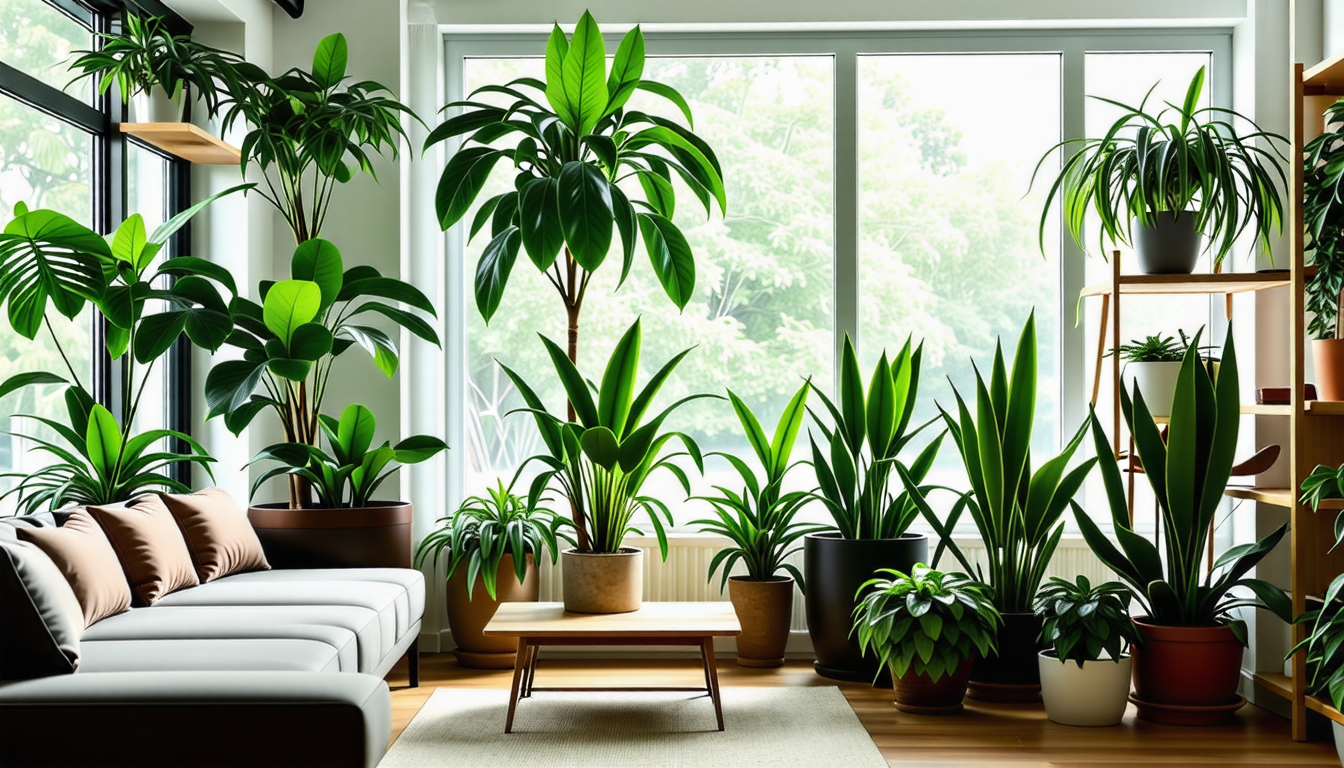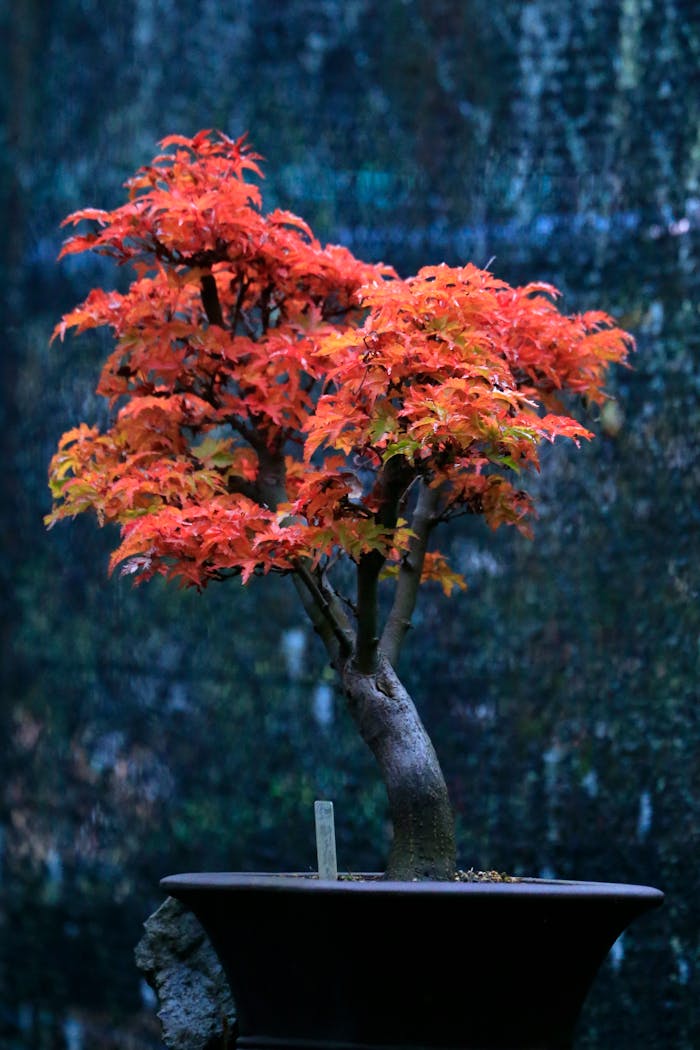|
IN BRIEF
|
Imagine stepping into your home and inhaling a breath of revitalizing air, where every corner is adorned with lush green life that doesn’t just please the eye but also works tirelessly behind the scenes. Indoor plants are your allies in transforming the atmosphere of your living space, making them essential for enhancing indoor air quality. From the elegant Peace Lily to the hardy Snake Plant, these green wonders have been scientifically recognized for their ability to filter out toxins and pollutants, making your home a sanctuary of pure air. Dive into the world of greenery as we explore the best plants not just to beautify your home but also to breathe new life into the air you cherish every day.

Improving indoor air quality can significantly impact your health and well-being. Not only do houseplants add a touch of greenery and style to your home, but they also play a vital role in purifying the air you breathe. By absorbing toxins, releasing oxygen, and increasing humidity, these plants create a healthier environment. Here’s a closer look at the best plants for enhancing indoor air quality and how they contribute to a better living space.
Nature’s Air Filters
Enhancing indoor air quality is an achievable goal, and with the right selection of plants, you can transform your home into a sanctuary. From the resilient Snake Plant to the vibrant Peace Lily, every plant can contribute significantly to the air in your home. As long as you pay attention to their respective needs and provide a nurturing environment, your indoor plants will thrive and promote better air quality. To explore more about the benefits of air-purifying houseplants, visit this informative page: The Best Air-Purifying Houseplants for a Healthier Home.
Enhancing indoor air quality is an achievable goal, and with the right selection of plants, you can transform your home into a sanctuary. From the resilient Snake Plant to the vibrant Peace Lily, every plant can contribute significantly to the air in your home. As long as you pay attention to their respective needs and provide a nurturing environment, your indoor plants will thrive and promote better air quality.
To explore more about the benefits of air-purifying houseplants, visit this informative page: The Best Air-Purifying Houseplants for a Healthier Home.
Snake Plant
The Snake Plant (Sansevieria trifasciata), also known as Mother-in-Law’s Tongue, is famous for its upright leaves that can grow tall and add an architectural element to your decor. This resilient plant is exceptionally adaptive, capable of flourishing in low light and needing very little water. The Snake Plant is known for its ability to convert carbon dioxide into oxygen at night, making it a perfect addition to your bedroom for improved air quality while you sleep. It excels at filtering out toxins like formaldehyde, benzene, and trichloroethylene.
Peace Lily
The Peace Lily (Spathiphyllum) is a stunning, elegant plant that not only purifies the air but also adds beauty to your home. Its beautiful white blooms and glossy green leaves make it a favorite in many homes. Peace Lilies are known for their ability to remove harmful chemicals such as ammonia, benzene, and formaldehyde. Moreover, they thrive in low light and require minimal care. Just ensure the soil remains moist but not soggy for optimal growth.
Bamboo Palm
The Bamboo Palm (Chamaedorea seifrizii) is a great option if you’re looking for a plant that brings a tropical vibe indoors. This palm is particularly effective in filtering out indoor air pollutants like formaldehyde and benzene. It enjoys bright, indirect sunlight, making it suitable for well-lit rooms. Additionally, Bamboo Palms can help maintain humidity levels, which is especially beneficial in drier climates. Regularly misting its leaves or placing it in a humid room will keep it flourishing.
Boston Fern
The Boston Fern (Nephrolepis exaltata) is a classic favorite among indoor plants. Its lush, feathery fronds not only add a touch of nature to your home but also make it an excellent air purifier. Known for its ability to absorb formaldehyde and other toxins, the Boston Fern thrives in higher humidity environments. It prefers indirect sunlight and requires consistent watering to maintain its vibrant appearance.
Dracaena
Whether you’re looking for a tall statement plant or a smaller variety, Dracaena offers versatility. This plant comes in various species and sizes, with some featuring striking striped leaves. Dracaenas are known to purify the air by removing pollutants such as benzene, formaldehyde, and trichloroethylene. They prefer bright, indirect light but can tolerate low-light conditions as well. Just be cautious not to overwater them, as well-drained soil is essential for their health.
Gerbera Daisy
Not only does the Gerbera Daisy (Gerbera jamesonii) brighten up your day with its vibrant blooms, but it is also a powerhouse when it comes to purifying the air. This cheerful flower is effective at eliminating benzene, formaldehyde, and trichloroethylene from indoor spaces. Gerbera Daisies thrive in bright light and will reward you with stunning flowers that bring joy to any room. Make sure to provide them with well-drained soil and water them regularly without letting them sit in water.
English Ivy
With its trailing vines and classic look, English Ivy (Hedera helix) is a popular choice for both decoration and air purification. This plant excels at removing airborne pollutants, particularly formaldehyde and mold spores. It’s ideal for hanging baskets or as a climbing plant on a trellis. English Ivy prefers cooler temperatures and moderate to bright indirect light. Regular pruning helps maintain its shape and encourages bushier growth.
Chrysanthemum
If you’re looking for blooms that also clean the air, consider the Chrysanthemum (Chrysanthemum morifolium). This flowering plant is not only beautiful with its vibrant colors but also effective at removing toxins like formaldehyde, benzene, and ammonia. Chrysanthemums love bright light and should be watered regularly to keep the soil moist. After blooming, they can be placed outdoors for continuous growth.
Pothos
The lovely Pothos (Epipremnum aureum), also known as Devil’s Ivy, is renowned for its hardiness and adaptability. This vine can grow in various lighting conditions, from low light to bright, and its heart-shaped leaves make it an attractive addition to any room. Pothos is exceptionally effective at removing indoor air pollutants like formaldehyde, benzene, and xylene. Water it when the soil dries out to maintain its vibrant appearance.
Strategies to Incorporate Plants into Your Home
The Role of Houseplants in Air Quality Improvement
Houseplants play a significant role in enhancing indoor air quality. Certain species, such as the peace lily and snake plant, are particularly effective at filtering harmful substances like formaldehyde and benzene from the air. They absorb these toxins through their leaves and roots, thereby promoting a healthier living environment. Moreover, the spider plant is known not only for its aesthetic appeal but also for its ability to remove pollutants, making it a favorite among indoor gardeners. By strategically placing these plants in your home, you can create a natural air purifier that works continuously.
Additionally, incorporating a variety of houseplants can make your space more inviting. For example, the Bamboo palm not only enhances air quality but also adds a touch of green to any room. In low-light areas, certain plants, like the philodendron, thrive and contribute to cleaner air conditions without demanding much light. This adaptability makes them perfect for urban dwellers facing space constraints.
Practical Examples and Benefits
Choosing the right houseplants can yield both aesthetic and health benefits. The Gerbera daisy, aside from brightening your decor, can help eliminate toxins while boosting indoor humidity levels. The increase in humidity can lead to improved respiratory health. As environmentalist Dr. Patrick Blanc once said, “Plants are the lungs of the planet.” This applies equally to our indoor spaces. For those seeking low-maintenance options, exploring easy-care plants can ensure an effortless way to maintain healthier air quality. Thus, investing in indoor plants is not only about beautifying your space but also enhancing your overall well-being.

One of the most incredible ways to elevate your living space is by nurturing a selection of the best plants for enhancing indoor air quality. Incorporating remarkable varieties such as the Peace Lily, Snake Plant, and Spider Plant not only beautifies your home but also works wonders in purifying the air around you. Each plant offers unique benefits, filtering out harmful toxins and improving overall air quality. As you choose the right species for your space, consider factors like light conditions and maintenance needs. By choosing vibrant greenery, you’re not just investing in decor; you’re also creating a healthier atmosphere for yourself and your loved ones. Live plants bring life, vitality, and essential clean air into your everyday environment.
Frequently Asked Questions about the Best Plants for Enhancing Indoor Air Quality
What are the best houseplants for improving indoor air quality? The top houseplants known for enhancing indoor air quality include Spider Plant, Snake Plant, Peace Lily, Bamboo Palm, and Boston Fern.
How do these plants help purify the air? These plants are effective because they absorb certain pollutants and release oxygen, which contributes to a healthier indoor environment.
Are all houseplants capable of improving air quality? While many houseplants can help, not all are equally effective. The ones specifically mentioned have been recognized for their air-purifying abilities.
Can I keep these plants in low-light conditions? Yes, several air-purifying plants, like the Snake Plant and Peace Lily, thrive in low-light spaces making them perfect for various rooms in your home.
Do these plants require special care? Most of the recommended plants are considered low-maintenance and do not require extensive care, making them ideal for busy lifestyles.
How many plants do I need for effective air purification? A few plants (at least two or three) can significantly improve air quality, but the more you add, the better the air purification effect will be.
Are these plants safe for pets? While many air-purifying plants are safe for pets, some like Peace Lily can be toxic to animals. It’s important to research each plant to ensure it fits your home.
Where is the best place to position these plants? Positioning these plants in well-lit areas can enhance their growth and air-purifying abilities. Avoid placing them in continuously dark or overly damp locations.
Can these houseplants reduce allergens? Yes, certain plants can help filter out common allergens from the air, potentially reducing symptoms for those with allergies.


